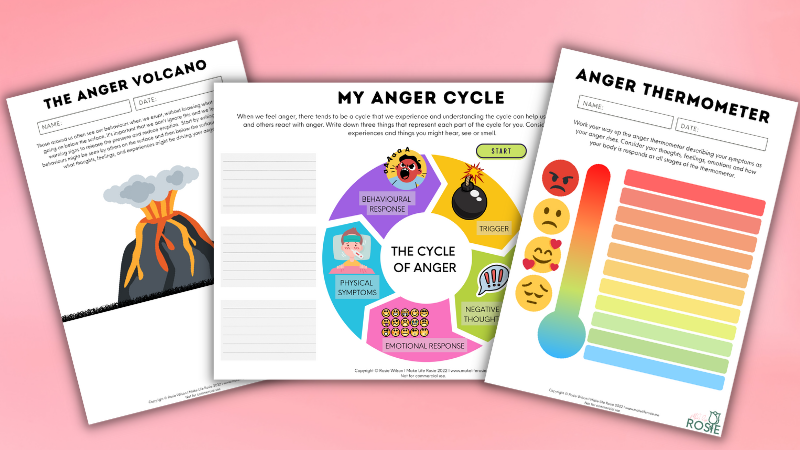Helping Young People Understand and Manage Anger
Every young person has felt anger at some point; maybe a friend said something hurtful, their parents disciplined them, or a teacher assigned a particularly overwhelming project. Anger is a natural and normal emotion; there’s nothing inherently wrong with feeling this way. What matters is how anger is managed and expressed.
Anger itself isn’t unhealthy. It’s the intensity and expression of anger that can make it helpful or harmful. Let’s explore what healthy and unhealthy anger looks like, what lies beneath this powerful emotion, and strategies young people can use to manage their anger constructively.
What Does Healthy and Unhealthy Anger Look Like? 🔍
Anger often gets a bad reputation because it’s associated with aggression or violence. However, anger is a healthy emotion that can serve as a tool for growth and problem-solving.
Healthy Anger 😠
Healthy anger is empowering. It motivates young people to take action, resolve conflicts, and address problems effectively. For example:
A teen feeling frustrated with a poor grade might use that energy to study harder for their next test.
A child upset by an argument with a friend might feel compelled to apologise or talk things through.
Healthy anger helps young people recognise threats, set boundaries, and advocate for themselves.
Unhealthy Anger 😡
Unhealthy anger tends to be more reactive and outwardly directed. It might manifest as blaming others, shouting, or lashing out. This type of anger often:
Escalates quickly, going from 0 to 100 in seconds.
Blows minor incidents out of proportion.
Masks deeper emotions like fear or sadness.
When anger becomes unhealthy, it’s harder to process underlying feelings or resolve the situation constructively.
What’s Beneath the Surface of Anger? 🌊
Anger is often a secondary emotion—what we see on the surface masks deeper feelings like:
Stress or Overwhelm: Struggling to manage responsibilities or expectations.
Fear: Worrying about outcomes or feeling unsafe.
Sadness: Coping with loss, disappointment, or loneliness.
Anxiety: Navigating uncertainty or change.
Hopelessness: Feeling stuck or powerless in a situation.
Older emotional wounds can amplify these feelings, making it even more critical to identify and address the root cause of anger in young people.
💡 Tip: Use tools like journaling, emotion wheels, anger warning signs, problematic anger or anger volcano to help young people explore what’s really going on beneath their anger.
Strategies to Manage Anger Effectively 📈
While anger can be challenging, there are many healthy ways for young people to cope. Here are a few key strategies:
1. Think Before Speaking
When emotions run high, it’s easy to say something hurtful in the heat of the moment. Encourage young people to pause, utilise a breathing strategy, and collect their thoughts before responding. If needed, taking a time-out to cool down can prevent escalation.
2. Express Concerns Assertively
Once calm, encourage young people to share their feelings in a way that is respectful and non-confrontational. For example, “I felt upset when you didn’t include me in the game” is more effective than yelling or blaming.
💡 Alternative: Journaling and practising self-care can be a great way to express frustrations when direct communication isn’t possible or safe.
3. Avoid Suppressing Emotions
Bottling up anger often leads to explosive outbursts later. Teach young people to address issues as they arise rather than letting emotions build up to a breaking point.
4. Seek Support
Sometimes, managing anger requires external help. Encourage young people to talk to a trusted adult, mentor, or mental health professional who can offer guidance and teach coping strategies.
Anger Doesn’t Have to Control Young People’s Lives 🌞
Anger is part of being human, which doesn’t mean a young person is “bad” or flawed. What’s important is learning to transform unhealthy anger into a tool for growth and self-improvement.
The journey to managing anger takes time, patience, and persistence. However, with the right support, young people can learn to channel their emotions in healthy ways, improving their well-being and relationships in the process.
Resources to Support Anger Management
To help young people better understand and manage their anger, I’ve developed a range of therapeutic tools and activities. Here are just a few:
Anger Volcano: Explore what triggers anger and how to respond constructively.
Negative and positive Coping Strategies: Explore what works and what doesn’t.
Ultimate Coping Playlist: Learn how to calm through music.
My Anger Cycle: Understand the stages of anger and how to break the cycle.
My Anger Warning Signs: Learn to identify and address anger before it escalates.
For more resources, check out my full collection of Anger Resources here.
Final Thoughts 💭
Anger doesn’t have to control young people’s lives. By helping them identify underlying emotions, understand their triggers, and develop healthy coping strategies, we can empower them to manage their anger constructively.
If you have any thoughts, questions, or suggestions, feel free to share them in the comments below, I’d love to hear from you! And if you’re looking for something specific, don’t hesitate to reach out to me via my contact page. Together, we can support young people in turning their anger into a powerful tool for growth and resilience. 🌱
Rosie 🌹


